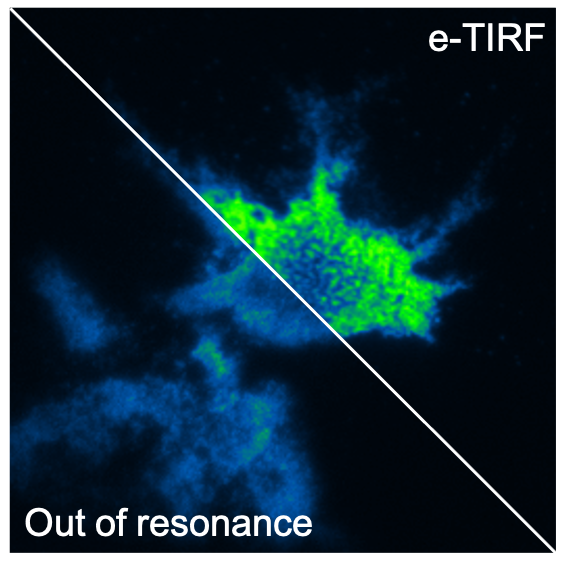Improved TIRF imaging through resonant dielectric multilayer optimization
Y. Toumi 1, A. Mouttou2, F. Lemarchand1, J. Lumeau1, C. Favard2,§ , G. Demesy 1,†, A. Lereu 1,‡
11 Aix Marseille Univ, CNRS, Centrale Marseille, Institut Fresnel, Marseille, France
22 Institut de Recherche en Infectiologie de Montpellier, CNRS, Univ of Montpellier France
§cyril.favard@irim.cnrs.fr
†guillaume.demesy@fresnel.fr
‡aude.lereu@fresnel.fr
Dielectric multilayers can be designed and fabricated to reach large optical field enhancement when working under total internal reflection. We demonstrated that such multilayer can be optimized to support a defined field enhancement at the free interface regardless of excitation wavelength and incident angle [1][2]. Although classically, used in sensing applications [3], we propose to use the resulting large field enhancement supported in such resonant multilayer in total internal reflection fluorescence microscopy (TIRF-M). Indeed, TIRF-M [4] uses evanescent wave illumination to selectively excite fluorophores in a thin layer of a sample near the enhancing substrate here the coated coverslip. This method is particularly useful for studying processes at the cell membrane. However, in TIRF-M, some limitations can affect image contrast and resolution. The aim here is to improve TIRF-M sensitivity by acting on the local excited field to amplify the collected fluorescence signal and gain in signal to noise ratio. We have already evidenced a 4-fold enhancement of the fluorescence in an objective based TIRF microscope [4][5] and 30-fold in a prism TIRF configuration. In this framework, we showed that angular divergence affects the excitation field and therefore the fluorescence enhancement and that the multilayer transmission also impacts fluorescence collection over spectral and angular ranges. Finally, we observed that the improvement of the fluorescence comes with an increase in the background noise as well. We, thus investigated the scattering effects also enhanced under resonance conditions [6]. Scattering over rough surfaces is associated to the presence of high spatial frequency deviations that can affect the optical response of multilayer. Hence, it is necessary to model the optical response of a rough structure. Here, we discuss the different aspects with advantages and limitations in using such resonant dielectric multilayers in TIRF-M.
The authors acknowledge the CNRS for financial supports through the 80|PRIME program and the French research agency through the ANR NIS.

Resonance visualization over the fluorescence enhancement of VLP-tagged cells
References
[1] C. Ndiaye, et al Appl. Opt. 50(9), C382, 2011
[2] A. L. Lereu, et al Proc. SPIE 9162, 916219, 2014
[3] A. L. Lereu, et al Appl. Phys. Lett. 111, 011107, 2017
[4] D. Axelrod J. of Cell Biology 141-5, 1981
[5] A. Mouttou, et al Opt. Exp., 30(9), 15365, 2022
[6] A. Mouttou, et al Optical Materials: X, 17, 100223, 2023
[7] A. L. Lereu, et al Appl. Opt. 53(4), A412, 2014

